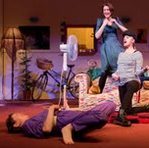SITE GUIDE
SEARCH
REVIEWS
REVIEW ARCHIVES
ADVERTISING AT CURTAINUP
FEATURES
NEWS
Etcetera and
Short Term Listings
LISTINGS
Broadway
Off-Broadway
NYC Restaurants
BOOKS and CDs
OTHER PLACES
Berkshires
London
California
New Jersey
DC
Connecticut
Philadelphia
Elsewhere
QUOTES
TKTS
PLAYWRIGHTS' ALBUMS
LETTERS TO EDITOR
FILM
LINKS
MISCELLANEOUS
Free Updates
Masthead
Writing for Us
A CurtainUp  London Review
London Review
 London Review
London ReviewDi and Viv and Rose
|
I am weird. I lie on the beach behind my sunglasses mentally dressing people.
— Viv
|

The cast dancing to The Cure
(Photo: Johan Persson) |
Anna Maxwell Martin is the ditsy, insecure Rose, whose death in the Second Act is from a road accident rather than AIDs. A sexually transmitted disease is what she deserves to die from with her promiscuous lifestyle and conversations about her vagina which she calls her “va”, at one point fanning her fanny (English for vagina), knees apart on the sofa in the communal living room. Rose is an idiote sexuelle as she sleeps with anyone who asks her and finds that men will sleep with her when she asks them to, which she does all the time. She is unable to finish her university degree because she is pregnant with twins and has to go back home to live with her mother and stepfather.
Gina McKee as serious minded Viv, described by Rose as the one who dresses “like the war” in formal frocks is a sociologist studying the oppression of the corset and will land on her feet with a well paid job in New York after writing to an American feminist writer. Tamzin Outhwaite, unrecognisable after her stunning performance as Charity Valentine, plays quirky Di, the sporty Lesbian who hasn’t told her mum about her sexual orientation.
There will be an audience which finds this play adorable and funny but I think it needed more work, more shaping, more editing. The dramatic shifts from a post rape scene of sisterly support to the death of Rose did not affect me because I didn’t believe or empathise with the characters so these life changing events didn’t leave the sting they should have. The dance scene, where the three fling themselves around to The Cure and collapse laughing, obviously pleased most of the audience and there will be those who can relate to this era and the life long bonds you can form with those you lived with in your late teens and early twenties. The rest of us have moved on.
The early scenes to introduce the characters are a series of cut scenes on a trio of black cut out frames, each jokey and a little bit like watching a stand up comedy routine. This story board approach applies to the whole production and seems set piece rather than organic. In the second half, over 27 years we see them coming together for reunions, a funeral and splitting up. The three actors work very hard but Anna Mackmin’s direction doesn’t credibly convey the passing of time and Bullmore’s play didn’t convey for me an understanding of female bonding.
|
Subscribe to our FREE email updates with a note from editor Elyse Sommer about additions to the website -- with main page hot links to the latest features posted at our numerous locations. To subscribe,
E-mail: esommer@curtainup.comesommer@curtainup.com
put SUBSCRIBE CURTAINUP EMAIL UPDATE in the subject line and your full name and email address in the body of the message -- if you can spare a minute, tell us how you came to CurtainUp and from what part of the country. |
| Di and Viv and Rose
Written by Amelia Bullmore Directed by Anna Mackmin Starring: Anna Maxwell Martin, Gina McKee and Tamzin Outhwaite Designed by Paul Wills Composer: Paul Englishby Lighting: Jason Taylor Sound: Simon Baker Choreography: Scarlett Mackmin Running time: Two hours 30 minutes with one interval Box Office: 020 7722 9301 Booking to 23rd February 2013 Reviewed by Lizzie Loveridge based on 23rd January 2013 at Hampstead Theatre, Eton Avenue NW3 3EU (Tube: Swiss Cottage) |
|
REVIEW FEEDBACK Highlight one of the responses below and click "copy" or"CTRL+C"
Paste the highlighted text into the subject line (CTRL+ V): Feel free to add detailed comments in the body of the email . . . also the names and emails of any friends to whom you'd like us to forward a copy of this review. |




